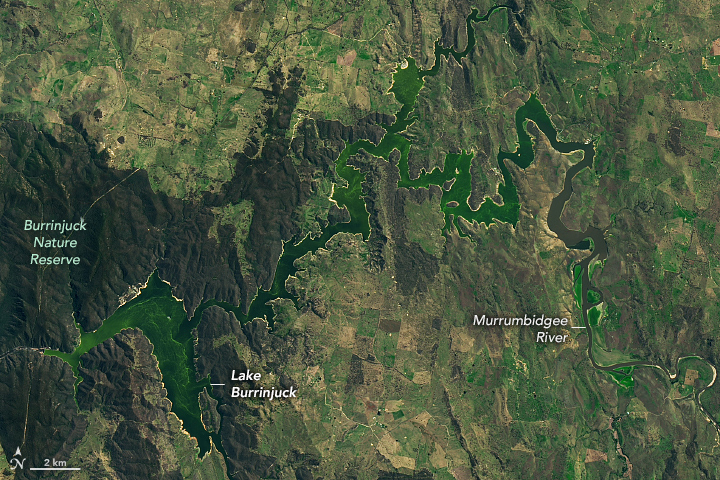File:Lakeburrinjuck oli 202141.jpg
Lakeburrinjuck_oli_202141.jpg (720 × 480 pixels, file size: 457 KB, MIME type: image/jpeg)
Captions
Captions
Summary[edit]
| DescriptionLakeburrinjuck oli 202141.jpg |
Deutsch: Seit Ende Januar 2021 haben sich blau-grüne Algen im Lake Burrinjuck in New South Wales, Australien, verbreitet. Die Behörden gaben Warnungen aus, in denen sie dazu aufforderten, aus dem Wasser des See zu bleiben. Dieser zieht üblicherweise viele Besucher an, die zu dieser Jahreszeit Wasserski betreiben und Angeln.
Am 10. Februar nahm der Operational Land Imager (OLI) au dem Satelliten Landsat 8 Bilder der Algenblüte au dem Lake Burrinjuck und dem Murrumbidgee River auf. Blaugrüne Algen, die als Cyanobakterien bekannt sind, erscheinen typischerweise als grünliche Klumpen oder Schwimmschlamm auf der Wasseroberfläche und haben einen starken modrigen Geruch. Dies geschieht natürlich in geringem Umfang, doch können günstige Umstände, insbesondere ausreichend Sonnenlicht, stehendes Wasser und hohe Mengen an gelösten Nährstoffen, etwa durch mit Dünger durchmischtes Regenwasser, zu einer raschen Vermehrung führen. Die Blüte blau-grüner Algen kann bei Aufnahme für Haustiere tödlich sein und bei Menschen Verdauungsprobleme bis hin zu Durchfall und Erbrechen hervorrufen. Sie kann auch die Fischpopulationen in dem See schädigen, der vor allem für seibe Populationen von Australischem Goldbarsch, Maccullochella peelii, Regenbogenforelle und andere. Wenn die Algen absterben, sinken sie auf den Grund des Sees ab, wo sie von Bakterien zersetzt werden, Wenn die Konzentration von Algen und Bakterien hoch genug sind, kann dieser Prozess dazu führen, daß im Wasser dieSauerstoffkonzentration augebraucht wird, sodaß Fische ersticken. Augrund von Algenproben entschied der staatliche Wasserversorger und Bewirtschafter des Flusses WaterNSW Warnungen zu veröffentlichen, nämlich Ende Januar und im Februar, und forderte dazu aufaus dem Wasser zuleiben und Erholungsaktivitäten im See einzustellen. Am 2. März eldete WaterNSW geringere Algenkonzentrationen, empahl den Anliegern allerdings, weiterhin kein Seewasser zu tringen und Vorsicht bei Aktivitäten in und auf dem Wasser walten zu lassen. Langjährige Anwohner sagten der Canberra Times, daß die Algenblüten die heftigsten waren, die sie seit mehr als einem Jahrzehnt erlebt haen. Nach Angaben von WaterNSW waren die Blüten insofern ungewöhnlich, als der See sich in einem kühleren Teil des Bundesstaates befindet und am Burrinjuck Dam erst kürzlich ein großer Zufluß von Wasser eingetroffen ist. Ein Presssprecher für WaterNSW sagte, da0 diese Zulüsse Nährstofe aus anderen Gebieten eingetragen hat.English: Since late January 2021, blue-green algae have spread across Lake Burrinjuck in New South Wales, Australia. Authorities issued warnings to stay out of the lake, which usually attracts many people for waterskiing and fishing around this time of the year.
On February 10, 2021, the Operational Land Imager (OLI) on Landsat 8 captured imagery of algae blooms in Lake Burrinjuck and the Murrumbidgee River. Blue-green algae, also known as cyanobacteria, typically appear as greenish clumps or scum on the surface of the water and have a strong musty odor. They occur naturally in modest numbers but can reproduce quickly under favorable circumstances—namely sufficient sunlight, stagnant water, and high amounts of dissolved nutrients, such as fertilizer runoff. Blue-green algae blooms can be fatal for pets and can cause stomach problems, rashes, and even vomiting for humans, if ingested. They could also harm the fish population at the lake, which is known for its golden perch, Murray cod, rainbow trout, and more. When the algae die, they sink to the bottom of the lake, where they are decomposed by bacteria. If the concentrations of algae and bacteria are high enough, the process can deplete oxygen concentrations in the water, causing fish to suffocate. Based on algal samples, the state-owned water supplier and river operator WaterNSW issued alerts in late January and February to stay out of the water and to stop recreational activities in the lake. As of March 2, it reported lower concentrations of algae but still advised people not to drink untreated lake water and to exercise caution if partaking in water activities. Longtime local residents told The Canberra Times that the algal outbreaks were the worst they have seen in more than a decade. According to WaterNSW, the blooms were somewhat unusual since the lake is located in a cooler part of the state and the Burrinjuck Dam recently received a large inflow of water. A spokesperson for WaterNSW said, however, the inflows may have brought in nutrients from other catchments. |
||||||
| Date | |||||||
| Source | https://earthobservatory.nasa.gov/images/148016/blue-green-algae-at-lake-burrinjuck | ||||||
| Author | NASA Earth Observatory images by Lauren Dauphin, using Landsat data from the U.S. Geological Survey. Story by Kasha Patel. | ||||||
| Permission (Reusing this file) |
|
||||||
| Other versions |
 zoomed Version, unlabeled  hi res, unlabeled |
References & Resources[edit]
- The Canberra Times (2021, February 28) Burrinjuck issues red alert as blue-green algae settles in at popular water-skiing spot. Accessed March 5, 2021.
- WaterNSW (2021, March 2) Blue-green algal red alert warning lifted for Burrinjuck Waters State Park. Accessed March 5, 2021.
- WaterNSW (2021, January 21) Blue-green Algal Alerts for the Murrumbidgee Region. Accessed March 5, 2021.
- WaterNSW (2021, February 10) Whole of Burrinjuck Dam on Red alert for blue-green algae. Accessed March 5, 2021.
- The Weather Channel (2021, February 25) Blue-Green Algae Bloom Stuns Family in Australia. Accessed March 5, 2021.
File history
Click on a date/time to view the file as it appeared at that time.
| Date/Time | Thumbnail | Dimensions | User | Comment | |
|---|---|---|---|---|---|
| current | 23:58, 20 March 2021 |  | 720 × 480 (457 KB) | Matthiasb (talk | contribs) | {{Information |Description={{de|1=Seit Ende Januar 2021 haben sich blau-grüne Algen im Lake Burrinjuck in New South Wales, Australien, verbreitet. Die Behörden gaben Warnungen aus, in denen sie dazu aufforderten, aus dem Wasser des See zu bleiben. Dieser zieht üblicherweise viele Besucher an, die zu dieser Jahreszeit Wasserski betreiben und Angeln. Am 10. Februar nahm der [https://landsat.gsfc.nasa.gov/landsat-8/operational-land-imager Operational Land Imager] (OLI) au dem Satelliten Landsat... |
You cannot overwrite this file.
File usage on Commons
The following 2 pages use this file:


